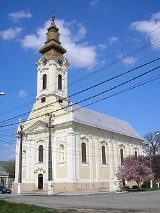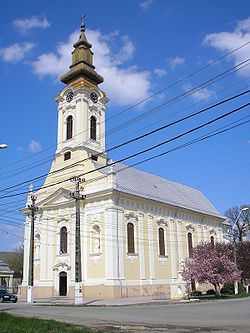
Dudestii Vechi
Encyclopedia

Timis County
Timiș , , Banat Bulgarian: ) is a county of western Romania, in the historical region Banat, with the county seat at Timișoara. It is the largest county in Romania in terms of land area....
, Romania
Romania
Romania is a country located at the crossroads of Central and Southeastern Europe, on the Lower Danube, within and outside the Carpathian arch, bordering on the Black Sea...
. Dudeştii Vechi is mostly populated by Banat Bulgarians
Banat Bulgarians
The Banat Bulgarians are a distinct Bulgarian minority group which settled in the 18th century in the region of the Banat, which was then ruled by the Habsburgs and after World War I was divided between Romania, Serbia, and Hungary...
(Palćene), a regional minority group of ethnic Bulgarians
Bulgarians
The Bulgarians are a South Slavic nation and ethnic group native to Bulgaria and neighbouring regions. Emigration has resulted in immigrant communities in a number of other countries.-History and ethnogenesis:...
that profess Roman Catholicism, who came from northern Bulgaria
Bulgaria
Bulgaria , officially the Republic of Bulgaria , is a parliamentary democracy within a unitary constitutional republic in Southeast Europe. The country borders Romania to the north, Serbia and Macedonia to the west, Greece and Turkey to the south, as well as the Black Sea to the east...
, and who are descendants of Paulicians that settled in the area around 1738. At the 2002 census, the total population of the commune numbered 5,789 people.
Languages
The commune is officially bilingual, with both RomanianRomanian language
Romanian Romanian Romanian (or Daco-Romanian; obsolete spellings Rumanian, Roumanian; self-designation: română, limba română ("the Romanian language") or românește (lit. "in Romanian") is a Romance language spoken by around 24 to 28 million people, primarily in Romania and Moldova...
and Bulgarian
Bulgarian language
Bulgarian is an Indo-European language, a member of the Slavic linguistic group.Bulgarian, along with the closely related Macedonian language, demonstrates several linguistic characteristics that set it apart from all other Slavic languages such as the elimination of case declension, the...
being used as working languages on public signage and in administration, education and justice.
Villages
The commune is composed of three villages: Cheglevici , Colonia Bulgară and Dudeştii Vechi. It also included VălcaniValcani
Vălcani is a commune in Timiş County, Romania. It is composed of a single village, Vălcani. An independent commune from 1877 to 1968, it was a village of Dudeştii Vechi Commune from that year until 2005, when it again became independent....
village until 2005, when it was split off to form a separate commune.
Colonia Bulgară (Banat Bulgarian: Telepa, ) was founded as Telepa by Roman Catholic Banat Bulgarian
Banat Bulgarians
The Banat Bulgarians are a distinct Bulgarian minority group which settled in the 18th century in the region of the Banat, which was then ruled by the Habsburgs and after World War I was divided between Romania, Serbia, and Hungary...
colonists in 1846. In 1910, it had a population of 714 Bulgarians. In 1930, the population was 830, of which 353 Bulgarians, 338 Hungarians, 123 Germans
Germans
The Germans are a Germanic ethnic group native to Central Europe. The English term Germans has referred to the German-speaking population of the Holy Roman Empire since the Late Middle Ages....
, 13 Romanians
Romanians
The Romanians are an ethnic group native to Romania, who speak Romanian; they are the majority inhabitants of Romania....
and 3 Roma. In the 1940 census, the Bulgarians were not recognized as a separate ethnic group by Ion Antonescu
Ion Antonescu
Ion Victor Antonescu was a Romanian soldier, authoritarian politician and convicted war criminal. The Prime Minister and Conducător during most of World War II, he presided over two successive wartime dictatorships...
's regime, and the population was 729, of which 314 "others", 295 Hungarians, 107 Germans and 13 Romanians.
Culture
The school in Dudeştii Vechi was founded in 1745 by the Bulgarian settlers with the help of the Roman Catholic Church. It is the oldest school of the Bulgarian diaspora and the only school in Romania where Bulgarian language is taught to all grades. , education in Bulgarian was optional, but efforts were made to transform the school into a bilingual one. http://www.standartnews.com/archive/2005/02/21/balkans/index.htmThe village also has an imposing Roman Catholic church.
2002
According to the 2002 Romanian census, the commune (also including three other villages) had a population of 5,807, a slight majority of which were Banat Bulgarians:- Banat BulgariansBanat BulgariansThe Banat Bulgarians are a distinct Bulgarian minority group which settled in the 18th century in the region of the Banat, which was then ruled by the Habsburgs and after World War I was divided between Romania, Serbia, and Hungary...
= 2,987 (51.44%) - RomaniansRomaniansThe Romanians are an ethnic group native to Romania, who speak Romanian; they are the majority inhabitants of Romania....
= 2,368 (40.78%) - Magyars = 330 (5.68%)
- Roma = 62
- GermansGermansThe Germans are a Germanic ethnic group native to Central Europe. The English term Germans has referred to the German-speaking population of the Holy Roman Empire since the Late Middle Ages....
= 44 - SerbsSerbsThe Serbs are a South Slavic ethnic group of the Balkans and southern Central Europe. Serbs are located mainly in Serbia, Montenegro and Bosnia and Herzegovina, and form a sizable minority in Croatia, the Republic of Macedonia and Slovenia. Likewise, Serbs are an officially recognized minority in...
= 16
2005
According to official 2005 calculations, the population of the municipality had dropped to 4,486.Table
| Census | Ethnic distribution | |||||||||
|---|---|---|---|---|---|---|---|---|---|---|
| Year | Population | Romanians Romanians The Romanians are an ethnic group native to Romania, who speak Romanian; they are the majority inhabitants of Romania.... |
Banat Bulgarians Banat Bulgarians The Banat Bulgarians are a distinct Bulgarian minority group which settled in the 18th century in the region of the Banat, which was then ruled by the Habsburgs and after World War I was divided between Romania, Serbia, and Hungary... |
Germans Germans The Germans are a Germanic ethnic group native to Central Europe. The English term Germans has referred to the German-speaking population of the Holy Roman Empire since the Late Middle Ages.... |
Magyars | Roma | Serbs Serbs The Serbs are a South Slavic ethnic group of the Balkans and southern Central Europe. Serbs are located mainly in Serbia, Montenegro and Bosnia and Herzegovina, and form a sizable minority in Croatia, the Republic of Macedonia and Slovenia. Likewise, Serbs are an officially recognized minority in... |
Jews Jews The Jews , also known as the Jewish people, are a nation and ethnoreligious group originating in the Israelites or Hebrews of the Ancient Near East. The Jewish ethnicity, nationality, and religion are strongly interrelated, as Judaism is the traditional faith of the Jewish nation... |
Slovaks Slovaks The Slovaks, Slovak people, or Slovakians are a West Slavic people that primarily inhabit Slovakia and speak the Slovak language, which is closely related to the Czech language.Most Slovaks today live within the borders of the independent Slovakia... |
Rest |
| 1880 | 11,690 | 2,754 | n.d | 1,295 | 1,101 | n.d | n.d | n.d | n.d | 6,366 |
| 1910 | 12,638 | 3,121 | n.d | 1,403 | 2,152 | n.d | n.d | n.d | n.d | 5,962 |
| 1941 | 11,334 | 2,661 | n.d | 1,206 | 1,187 | n.d | n.d | n.d | n.d | 6,280 |
| 1948 | 11,620 | 2,754 | 5,771 | 1,327 | 1,415 | 232 | 53 | 34 | 20 | - |
| 1956 | 9,653 | 2,340 | 5,610 | 478 | 995 | 210 | 6 | 5 | 7 | - |
| 1977 | 8,030 | 2,221 | 4,669 | 319 | 694 | 109 | 6 | 2 | 5 | 9 |
| 1992 | 6,409 | 1,996 | 3,633 | 57 | 379 | 305 | 11 | 1 | 9 | 17 |
| 2002 | 5,807 | 2,368 | 2,987 | 44 | 330 | 62 | 16 | − | − | − |
Chart and Table
| Population trend (Growth/Downtrend) | |||||||
|---|---|---|---|---|---|---|---|
External links
- 2002 census data
- Star Bisnov, Dudeştii Vechi website

